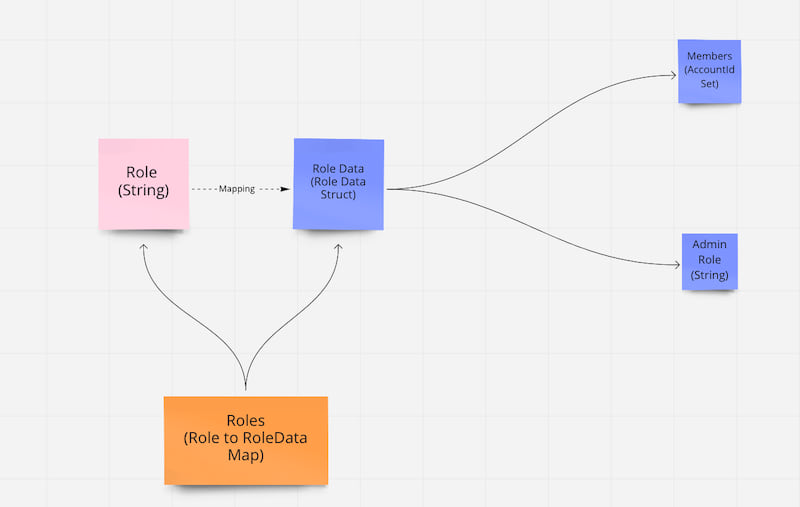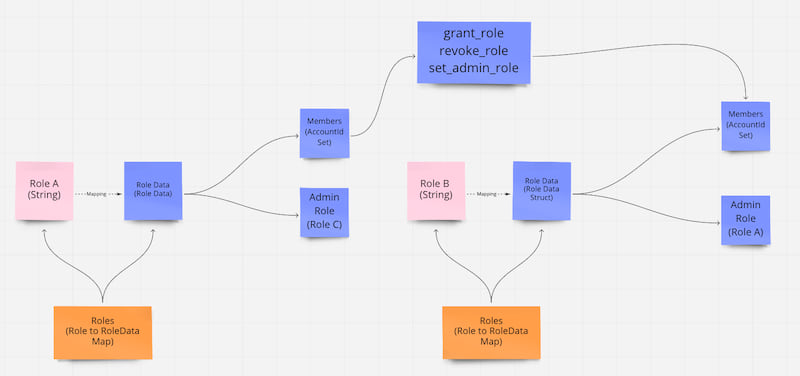| 0.1.8 |
|
|---|---|
| 0.1.7 |
|
#5 in #near-blockchain
24 downloads per month
310KB
Access Control NEAR
Access Control NEAR is a library for implementing role-based access control model in NEAR smart contracts. It is partially inspired by OpenZeppelin's access control implementation.
Architecture
The Roles map consists of Role to Role Data mapping. New members are added to the members set by inserting new AccountId. Each role has an Admin Role, whose members are allowed to perform privileged actions on the role that derives it. Default admin_role for all created roles is default_admin
Methods
There are private and public methods. Private methods can only be called by the smart contract itself.
Public Methods
fn has_role(&self, role: &String, account: &AccountId) -> bool;
fn check_role(&self, role: &String, account: &AccountId);
fn assert_role(&self, role: &String);
fn assert_self(&mut self);
fn get_role_admin(&self, role: &String) -> String;
fn get_account_roles(&self, account: &AccountId) -> Vec<String>;
fn grant_role(&mut self, role: &String, account: &AccountId);
fn revoke_role(&mut self, role: &String, account: &AccountId);
fn set_admin_role(&mut self, role: &String, admin_role: &String);
- has_role: Checks if given account has the given role. Returns bool
- check_role: Checks if given account has the given role. Panics with a message
- assert_role: Checks whether the caller has given role. Panics with a message. Internally calls check_role with
env::predecessor_account_id() - assert_self: Checks whether the account of the caller equals to the account of the smart contract. Makes certain functions private
- get_role_admin: View method. Gets the admin role of a given role. Returns String
- get_account_roles: View method. Gets all roles that the given account has. Returns a vector containing all the roles
- grant_role: Can only be called by the role admin of given role. Grants given role to given account.
- revoke_role: Can only be called by the role admin of given role. Revokes given role for given account.
- set_admin_role: Can only be called by the role admin of given role. Sets the new admin role for given role.
Private Methods
fn setup_account_role(&mut self, role: &String, account: &AccountId);
- setup_account_role: Sets the given role to given account. If role does not exist it first creates by calling add_role.
Private Helper Methods
fn add_role(&mut self, role: &String);
fn delete_role_member(&mut self, role: &String, account: &AccountId);
fn add_role_member(&mut self, role: &String, account: &AccountId);
- add_role: Adds a new role and sets
default_adminas the admin_role - delete_role_member: Deletes a member from a role.
- add_role_member: Adds a new member to a role.
Usage
You can run the test application in the example folder, which is a fork of StatusMessage by calling ./build.sh and then ./deploy.sh . Please update ./deploy.sh to have your accounts. For your own projects you have to include both access_control_near and access_control_near_attribute crates.
The only thing needed is to add #[access_control] attribute macro to your main struct to begin using methods from this library. Please also note that #[access_control] macro already includes #[derive(BorshDeserialize, BorshSerialize, PanicOnDefault)] . Therefore, please do not derive it the second time on your main struct, where the #[access_control] is used.
use access_control_near::AccessControl;
use access_control_near_attribute::access_control;
...
#[near_bindgen]
#[access_control]
pub struct StatusMessage {
records: LookupMap<String, String>,
}
Then, to begin using methods in the Access Control NEAR and setup initial roles, you have to first call the init_roles!() macro in your constructor and then setup roles you want to use.
const DEFAULT_ADMIN: &str = "default_admin";
const MINTER: &str = "minter";
const MANAGER: &str = "manager";
.....
#[near_bindgen]
impl StatusMessage {
#[init]
pub fn new(owner: AccountId, minter: AccountId, manager: AccountId) -> Self {
assert!(!env::state_exists(), "The contract is already initialized.");
let mut constructor = init_roles!(Self {
records: LookupMap::new(StorageKey::Records.into_bytes()),
});
constructor.setup_account_role(&DEFAULT_ADMIN.to_string(), &owner);
constructor.setup_account_role(&MINTER.to_string(), &minter);
constructor.setup_account_role(&MANAGER.to_string(), &manager);
constructor
}
That's all! From now on, you can directly use Access Control NEAR methods within your smart contract.
Future Plans
- Finishing up tests
- Doing an audit for this library
- Making stricter version, where one account is only allowed to have one role
Licence
Dependencies
~11MB
~203K SLoC

